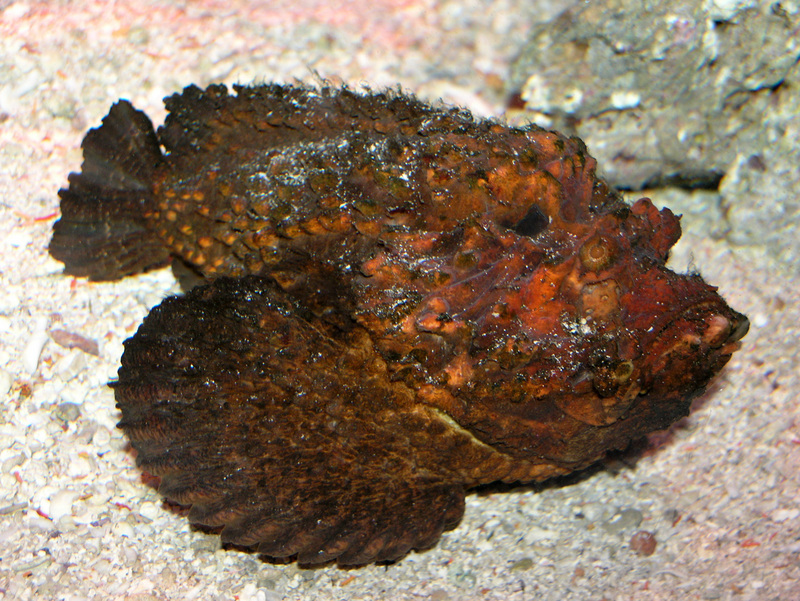ERROR : Server Busy(-1105)
ERROR : Server Busy(-1105)
Stonefish (Synanceia verrucosa) - Wiki
Stonefish
From Wikipedia, the free encyclopedia
[Photo] Stonefish (Synanceia verrucosa). Date: 30 June 2006. Photo by SeanMack.
The stonefish, Synanceia verrucosa, also known as the the reef stone or dornorn is a carnivorous ray-finned fish with venomous spines that lives on reef bottoms, camouflaged as a rock. It is the most venomous fish in the world.
Range
The stonefish lives primarily above the tropic of Capricorn: It is the most widespread species of the stonefishes family, and is known to be found in the shallow tropical marine waters of the Pacific and Indian oceans, ranging from the Red Sea to the Queensland Great Barrier Reef.
Description
The average length of most stonefish is about 35-50 centimeters. It has a mottled greenish to mostly brown color which aids in its ability to camouflage itself among the rocks of many of the tropical reefs. The fish eats mostly small fish, shrimp and other crustaceans.
Habitat
Its main habitat is on coral reefs,around dull coloured plants near and about rocks, or can be found dormant in the mud or sand.
Points of note
The primary commercial significance of the stonefish is as an aquarium pet, but they are also sold for their meat in Hong Kong markets. In addition, stonefish is also consumed in Japan as expensive sashimi cuisine (called okoze, オコゼ). Stonefish can survive out of water for up to 20 hours.
Venom
Its dorsal area is lined with spines that release a venomous toxin. It is the most dangerous of known venomous fish and its venom causes severe pain with possible shock, paralysis, and tissue death depending on the depth of the penetration. This level can be fatal to humans if not given medical attention within a couple of hours. Immediate first aid treatment requires the immobilisation of venom at penetration site; depending on the depth of penetration this can be achieved either by firm constrictive bandaging or by a managed tourniquet sited between wound and proximal flexure.
The venom consists of a mixture of proteins, including the hemolytic stonustoxin, the neurotoxic trachynilysin and the cardioactive cardioleputin; an antivenin is available.
Since the venom is protein based, it can be denatured by the application of a very hot compress to the injury site. Some relief can be gained from infiltrating the wound with a local anaesthetic. This is a temporary measure to reduce localised pain and shock. Medical help must be sought at the earliest opportunity. Typically, surviving victims suffer localised nerve damage occasionally leading to atrophy of adjoining muscle tissues.
There have been unproven reports of osteo-arthritic sufferers experiencing improved mobility and reduction in joint pain following envenomation episode. The responsible agent has not been identified.
The pain is said to be so bad that the victims of its sting want to cut off the affected limb. The poisonous sting of Scorpion Fish and Lionfish are said to deliver the same level of pain.
http://en.wikipedia.org/wiki/Stonefish
| The text in this page is based on the copyrighted Wikipedia article shown in above URL. It is used under the GNU Free Documentation License. You may redistribute it, verbatim or modified, providing that you comply with the terms of the GFDL. |
|

